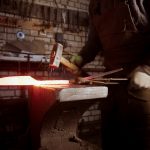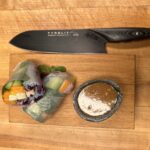Types of Whetstones – Materials, Shapes, and Uses
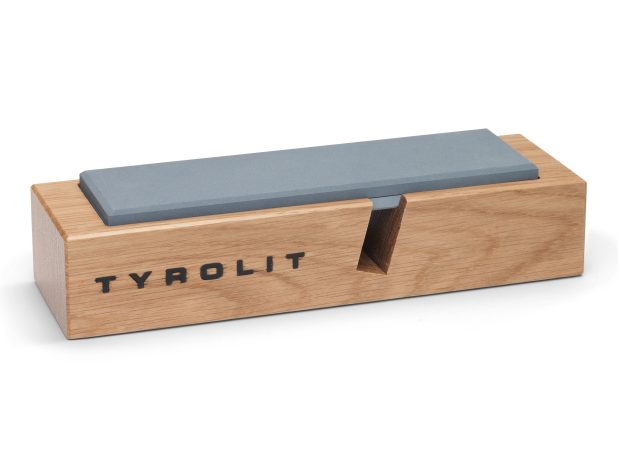
To differentiate between various types of whetstones or sharpening stones, one can examine them from multiple perspectives. The materials used, shape, and manner of application all serve as valuable criteria to ensure one does not lose sight of what to look for when purchasing a sharpening stone for either personal or professional kitchen use.
Choosing the right sharpening stone is anything but trivial: it is only by regularly sharpening knives that they retain their sharpness. In order to provide an overview here, we will introduce you to different types of grinding stones in this article. In addition, we will show you how we at Tyrolit, as long-standing abrasive experts, have further developed the classic sharpening stone into our innovative knife sharpeners.
How to use a sharpening stone? The basics
When sharpening blunt knives with a sharpening stone, it is crucial to apply the correct technique and understand the basics.
Proper angle maintenance is crucial, as the knife must be held at a consistent angle to the sharpening stone. It is important to adhere to the manufacturer’s recommendations for the correct angle. Generally speaking, a sharpening angle of 15° is considered ideal for most types of European knives. Nonetheless, maintaining a specific angle consistently during sharpening requires some practice.
In addition, an even and flowing movement over the grindstone is crucial. The knife should be guided with constant pressure on both sides of the blade to ensure even sharpening.
Before sanding, it is important to thoroughly clean the grindstone for optimal results. For natural stones, it may be necessary to soak them in water before use, while synthetic stones should only be slightly moistened.
The Role of Grain
The different grits and grain sizes of the grindstone play a crucial role in the grinding process of your cutting tools. A coarse grind with coarse grit is ideal for heavily worn blades, as it effectively removes material and shapes the base grind – for example with a grit of 400.
The high grit finish (e.g. 800), on the other hand, gives the blade the final touch, sharpens precisely and ensures a smooth, sharp edge. After the actual grinding process, the blade can be polished with a fine grit to achieve additional sharpness and smoothness.
Natural stone grindstones
Natural stone has been used for millennia for grinding. In the Neolithic era, for example, they were used to sharpen axe blades made of flint, which was characteristic at the time.1
The sharpening methods have evolved considerably since that time; however, natural sharpening stones are still popular tools to provide amazing sharpening results in the kitchen.
Which materials are suitable?
Natural sharpening stones from quarries in European regions and beyond have a wide choice of materials – here are some of them:
- Silicon carbide: This mineral is particularly suitable for grinding hard materials such as glass or tiles.
- Corundum: Corundum is characterized by its hardness and is very popular when sharpening knives, for example.
- Belgian Coticule: This stone possesses a unique mineralogical composition that is renowned for its exceptional sharpening quality.
- Novaculite: A hard rock that is appreciated for its fine grit and hardness and is particularly suitable for fine grinding work.
- Agate: A mineral quartz rock popular in jewelry making. Agate can be used in some grinding stones for its polishing properties.
- Slate: Due to its fine grit, slate is particularly suitable for precise grinding and fine sharpening of knife blades.
Advantages and Disadvantages of natural stone as Sharpening Stones
Sharping stones or whetstones made of natural stone offer a variety of advantages and disadvantages that should be taken into account when using them. Here are some aspects that have both positive and negative sides:
Advantages of natural stone as sharpening stones:
- Natural grinding sensation: Natural grinding stones often provide a pleasant and natural grinding sensation that is appreciated by many users.
- Versatility: Natural stones can be found in different grits and materials, allowing for a wide range of applications, from coarse grinding to fine grinding.
Disadvantages of natural stones as sharpening stones:
- Irregularities: Natural stones may have irregularities that can affect the consistency of the grinding process.
- Limited availability: High-quality natural stones can be limited and expensive, depending on their origin and composition.
- Care: Natural grindstones may require more care because they can be sensitive to certain cleaning methods.
Whetstones made from synthetic materials
Synthetic whetstones are artificially produced abrasives that provide an even grinding surface. Sharpening stones or whetstones made of synthetic materials offer a modern alternative to natural stones and are offered in various designs.
Synthetic whetstones often offer improved durability and sharpening performance compared to natural stones and are a popular choice for professionals and hobbyists alike. Materials such as ceramics, diamond, aluminium oxide and many more are suitable for these sharpening stones.
Synthetic sharpening stones can be used for various sharpening tasks and provide an efficient way to keep knife blades in top shape.
Diamond sharpening stones
Diamond sharpening stones are known for their hardness and efficiency when sharpening knives. The use of diamond particles on the surface allows for rapid and precise removal of metal.
Advantages of diamond sharpening stones:
- High abrasion performance: Diamond sharpening stones provide quick and efficient removal of material, resulting in a quick sharpening result.
- Durability: Due to the hardness of diamonds, these sharpening stones are extremely durable and maintain their sharpening performance over long periods of time.
- Versatility: They are suitable for various cutting tools, including kitchen knives, axes and other tools.
Disadvantages of Diamond Sharpening Stones:
- Cost: Diamond sharpening stones can be more expensive than some other sharpening stone options.
- Coarseness: With coarse grains, diamond stones can wear out the knife faster than finer abrasives.
Ceramic Sharpening Stones
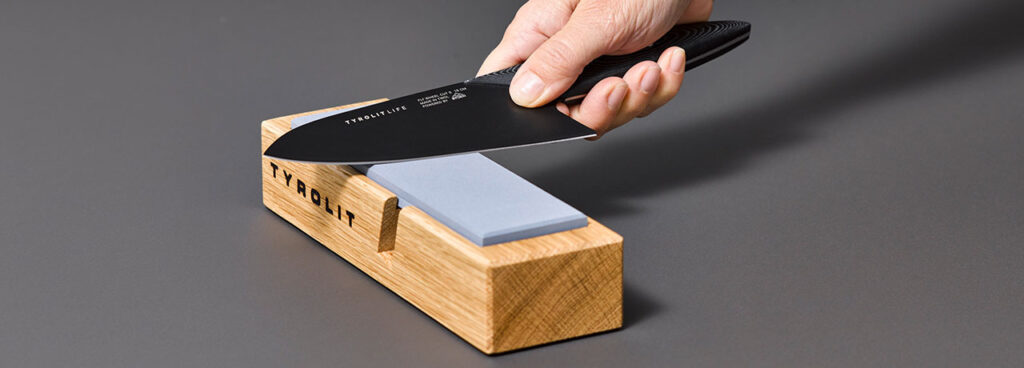
Ceramic sharpening stones are modern favorites when sharpening knives. Thanks to their high-quality, even surface, they enable precise grinding. Their hardness and durability result in a long service life.
The included binder stabilizes the stone, while its versatility enables both coarse and fine sharpening. Ceramic sharpening stones are less susceptible to wear, promoting their economical use.
Advantages of ceramic whetstones
- Precise sharpening: The even surface allows for a precise and sharp sharpening of knife blades.
- Hardness and durability: Ceramic grindstones are hard and durable, resulting in a long service life.
- Versatility: They offer the possibility for both coarse and fine grinding, which widens their range of applications.
- Less susceptible to wear: Compared to some other materials, ceramic grindstones are less susceptible to wear.
Disadvantages of ceramic sharpening stones:
- Risk of breakage: Due to their hardness, ceramic grindstones are prone to breakage, especially if handled improperly.
- Higher price: Ceramic sharpening stones tend to be more expensive than some other grindstone materials.
Due to the numerous advantages in both private and professional use, well-known abrasive experts such as Tyrolit rely in particular on ceramic as the building material for their grinding stones.
Water Stones vs. Oil Stones: The Differences
When sharpening knives, there are various types of sharpening stones available, including water stones and oil stones. The choice between them depends on personal preference and the desired sharpening process, as both types are used in both private and professional settings.
Waterstones require water as a lubricant. They are favored for their ease of handling, as water is more readily available. Japanese waterstones are particularly widespread in the Asian knife tradition.
Oil stones, on the other hand, use special grinding oil to reduce friction. This allows for an efficient sharpening process and protects the stone from excessive wear.
Different Forms of Sharpening Stones
Sharpening stones offer a variety of shapes to meet the different requirements. A double-sided grindstone with two grits enables a seamless transition from rough grinding to fine work – such as Tyrolit’s 400/800 grit grindstones.
Rectangular stones offer generous work surfaces, while specifically shaped variants are tailored to specific tools. Whether flat, conical or oval, each shape influences the handling and precision of the grinding process.
Ceramic whetstone 2.0 – Sharpen knives with Tyrolit Life
Tyrolit Life, a Tyrolean abrasive expert with decades of experience, has significantly evolved the traditional ceramic whetstone. A major challenge in using whetstones for knives, regardless of their material, is the handling, which demands dexterity and practice, especially for beginners.
Particularly, maintaining the correct sharpening angle is facilitated by innovative whetstones or knife sharpeners with a preset angle of 15°. And by integrating whetstones into other kitchen aids, knife sharpening becomes an effortless task. Is there a difference between a whetstone and a knife sharpener? At Tyrolit Life, there isn’t, as the benefits of both worlds are combined.
Knife Sharpeners for Beginners and Professionals
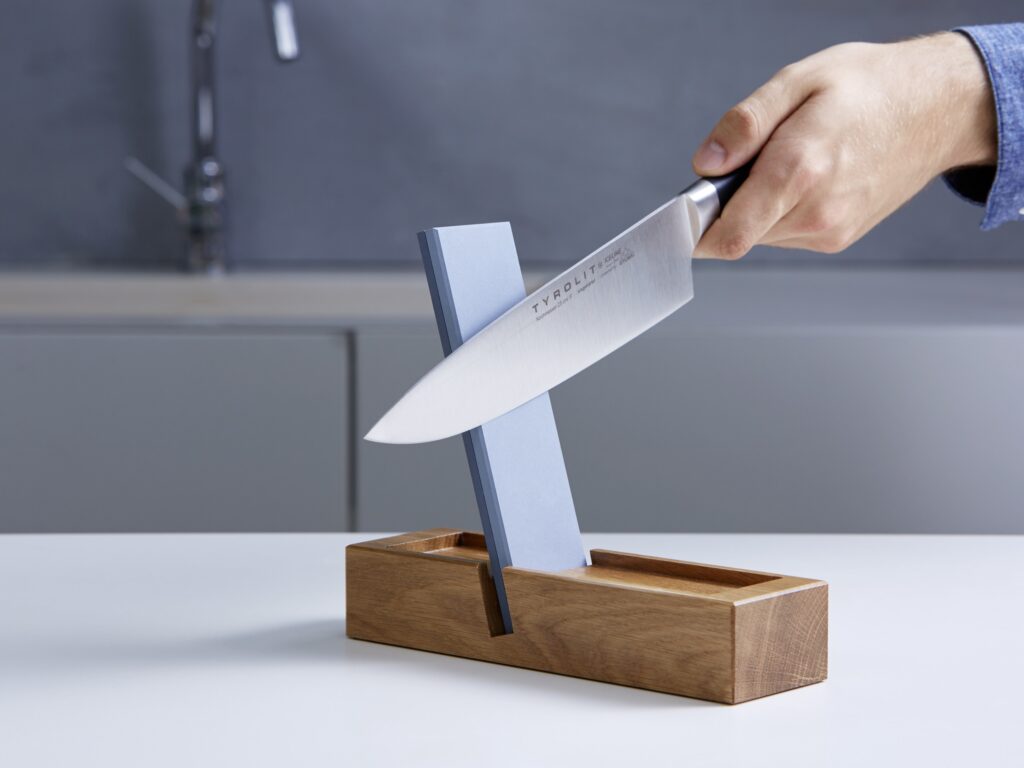
The Tyrolit knife sharpener is the ideal solution for both beginners and professionals. Available in both wood and acrylic, it provides a user-friendly means to effortlessly sharpen knives.
The wood version impresses with its natural aesthetics and robustness, while the acrylic version combines modern design and durability. Both versions are characterized by their ease of use and allow precise sharpening with a preset angle of 15° – ideal for most European knife types.
Integrated whetstones – in knife block and cutting board
Innovation and functionality are combined in Tyrolit Life’s integrated sharpening stones. In both the knife block and on the cutting board, these stones offer a revolutionary means of effortlessly sharpening your knives.
The knife block presents itself as a stylish storage solution with a magnetic wooden design and integrated sharpening stone. This not only protects your knives but also maintains their desired sharpness.
Tyrolit Life cutting boards are equipped with removable ceramic grinding stones. These allow for effortless sharpening during cutting. With a non-slip design, the cutting boards provide an efficient solution for precise cutting and sharpening in one.
Pizza stone from Tyrolit – for the final touch of your pizza
Although the pizza stone from Tyrolit is not intended for sanding, it also convinces with its innovative design and excellent results.
Thanks to the waffle structure on the bottom of the cordierite stone, it heats up especially efficiently. It then distributes the heat evenly to the baked goods – for crispy pizzas, breads, and other bakery products.
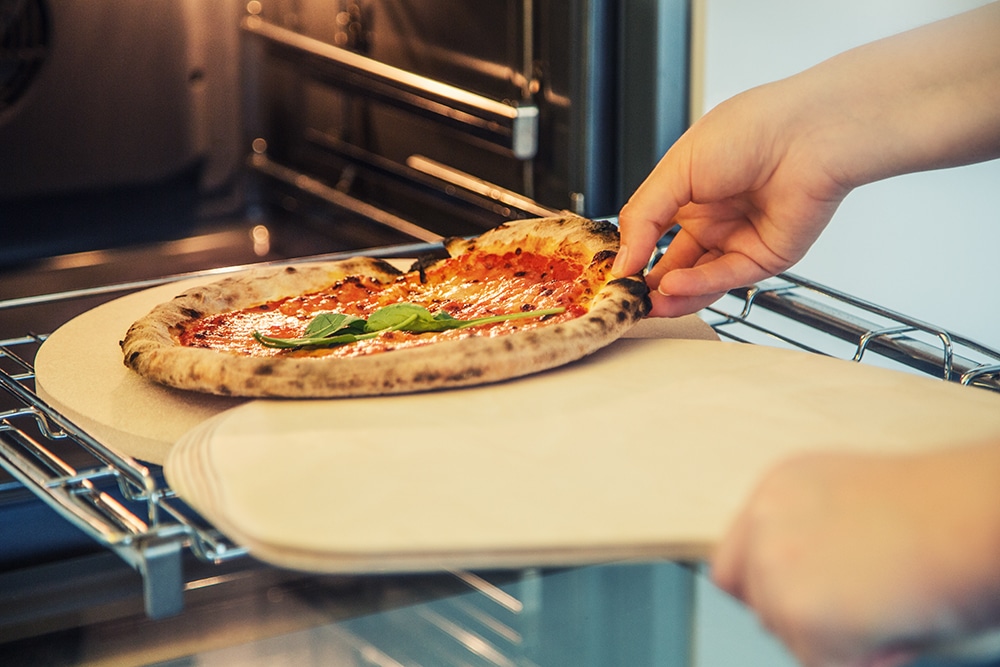
Sources:
1 https://bodendenkmalpflege.lvr.de/de/aktuelles/fund_des_monats/2018/fdm_2018_04.html

